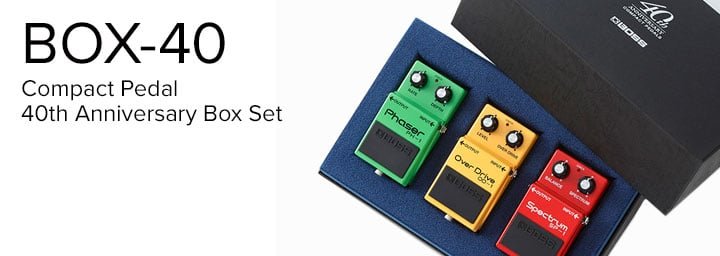If you’re a guitar player, there’s an extremely good chance that you’ll have used, are currently using, or plan to use, BOSS Compact Pedals at some stage in your life.
Often considered a “Gold Standard” in design, sound and practicality, BOSS Compact Pedal sales reach over 15 million units worldwide. These beloved little stompboxes are at the feet of everyone from professional musicians, studio engineers and players at home.
They’ve made their way onto millions of records and sat on probably every performance stage in the world. BOSS Compact Pedals have even played a significant role in shaping entire genres of music! BOSS Compact Pedals are truly ubiquitous. As a result, they don’t always get a second thought, other than being taken for granted that they will deliver great results, function intuitively and just work!
It’s often easy to forget just how many heads BOSS turned in 1977, when they launched the first three models of BOSS Compact Pedals onto an unsuspecting guitar community.
The OD-1 OverDrive, PH-1 Phaser and SP-1 Spectrum compact pedals not only sounded great, but represented a quantum leap forward in both electronic and physical design, while setting the (still unsurpassed) new standard in build quality and reliability.
To understand today just how pivotal the BOSS Compact Pedal design was to the music world, let’s look back to the 1970s and what effects pedals were like before BOSS Compacts hit the scene.
Contributed by Byron Struck for the Roland Australia Blog
Big pedals are the order of the day for 70s guitar players
Despite being one of the most iconic eras of guitar music, effects pedals in the early 1970s were very limited.
A typical guitar setup in the 1970s might include one or two pedals. And that was at a professional level! Fuzz pedals and treble boosters were the pedals of the day – virtual requirements for teasing rock and roll guitar tones from the guitar amps of the era. Wah pedals were also popular, thanks to Jimi Hendrix’s mastery of the effect in the late 1960s.
Beyond this however, pedals really were a rarity. UniVibes, Flangers and a few other similar pedals were around, but were certainly not commonplace on the average guitar player’s rig. Even at the height of The Who’s fame in the early to mid-70s, Pete Townshend was using just a single, solitary fuzz pedal! *
* That is pretty cool though. Especially by today’s standards!
Most non-rock star, bedroom/garage band guitarists in the early 1970s probably couldn’t afford to buy multiple pedals… if they even considered using them at all! It was extremely rare for the average guitar player to have multiple pedals, let alone a whole board.
It wasn’t just a cost issue though. The other notable feature of many classic guitar effects were just how HUGE they were – in both size and weight.
By 1977, the Roland Corporation had been actively working in the musical space since the early years of the decade, with instruments and accessories for all kinds of musicians. There were even pedals released, like the AS-1 Sustainer, the AG-5 Funny Cat(!), the AF-100 Bee Baa and other unusually named devices.
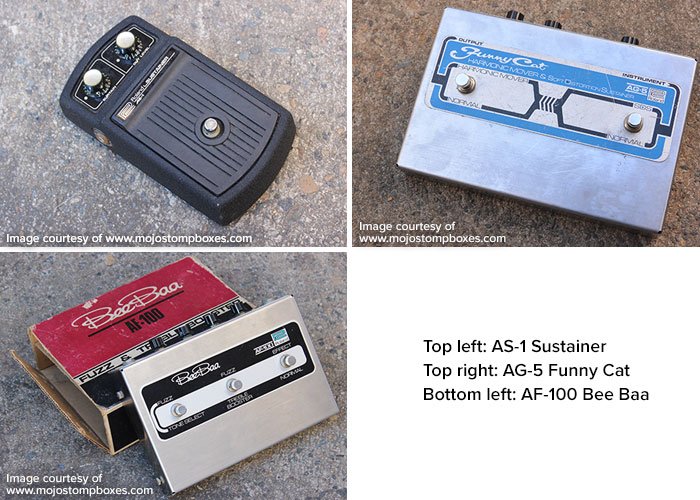
By 1976, a subsidiary of Roland, the BOSS Corporation, had released 4 pedals – the GE-10 Graphic Equalizer, the CE-1 Chorus Ensemble (not only the world’s first chorus pedal, but the first BOSS pedal ever), the BF-1 Flanger and the DB-5 BOSS Driver.
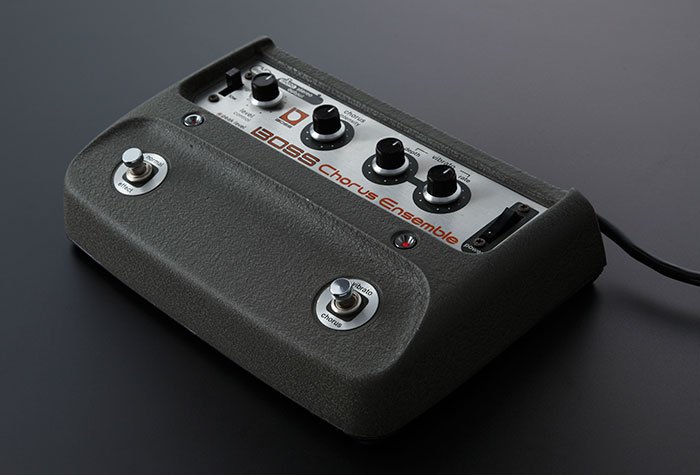
The sound of these early BOSS pedals were extremely well-regarded, but they were typical of their era, as you can see by the image above. Note the size and control section!
The size of these pedals wasn’t a clever marketing ploy or designed to deliberately draw attention to them. It’s just the way pedals were back then! Largely (no pun intended), the size was due to necessity. The electronic components of the time were large and fitting the circuitry into a suitable housing required space.
This was soon to change though…
Electronics have reduced, why can’t guitar pedals?
The late 1960s really kickstarted the beginning of the microelectronics boom. A lot of this boom was due to the massive investment made by governments competing in the “Space Race”, and the goal to put a person on the moon.
As a direct result, advances in semiconductor technology were rapidly enabling smaller and cheaper electronic components. By the early 1970s, this technology was trickling into the musical world and the first compact-sized pedals from guitar effect companies appeared.
The first wave of compact pedals from both American and Japanese manufacturers were enthusiastically received by guitar players. Players responded favourably to their portability and their (substantially) lower price.
They were still, however, a fairly low-tech affair. These pedals often used simple DIY-style “project boxes”, bought off the shelf at an electrical supply store. The “button” footswitches were of a simple design too – old technology repurposed from the larger, older pedals.
BOSS Corporation were eyeing this emerging trend of compact pedals with interest. Having found some success with their earlier “big box” pedals (most notably the now-legendary CE-1 Chorus Ensemble), it was becoming apparent to BOSS that effects pedals were going to have more of a future than some manufacturers, critics and even musicians had previously considered.
Roland and BOSS’ founder, Mr. Ikutaro Kakehashi, was hungry to push both sonic and design boundaries and with this motivation, made the decision to “work within severe constraints to deliver maximum potential to musicians.”
BOSS made the decision to begin development on a range of compact guitar pedals that would sound great, while being lightweight and could easily fit into a guitar case.
And so it began….
Designing the legend – compact pedals and the future
In the mid-1970s, BOSS began an investigation which led to a total rethink of how stompboxes could function. This was a look at effects pedals as a whole, considering things such as what players liked about them, what required improvements and how those improvements could be technologically implemented.
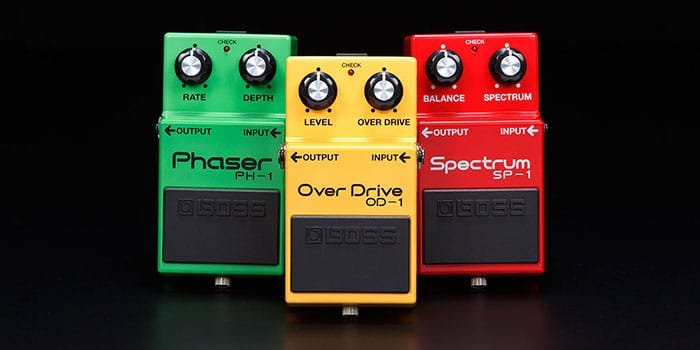
By merging the best elements of existing stompboxes and reversing the weak points that were impacting use of effects pedals, BOSS successfully streamlined and refined their pedal designs to include these revolutionary advances:
1) Portability
First and foremost, was the importance of the “compact” size. The classic die-cast BOSS pedal chassis hasn’t changed since its introduction in 1977. It’s gone on to inspire the size and design of compact stompboxes ever since.
BOSS’ new design provided musicians with not only a portable, compact unit, but the metal casing ensured it was tough, durable and as the saying goes, “built like a tank.”
The use of aluminium for the chassis ensured its lightweight usability when compared to competitors and was therefore ideal for transporting.
The dimensions used on the SP-1, the PH-1 and the OD-1, which subsequently remain the standard for all BOSS effects are:
* 125mm long
* 70mm wide
* 55mm high
2) Heavy Duty Stompbox Construction
It is well known that BOSS stompboxes are tough. The thick all-metal cast construction of the case is very durable and provides very strong protection for the circuitry inside.
We have seen cars driven over them, after which they still work (we’re not advocating this, by the way). In the early days, BOSS engineers used to test them by throwing them out of a second story window!
Every component is tested to withstand extreme use. The spec for the electronic switch, for example, specifies that it must be able to withstand a minimum of 100,000 stomps. BOSS has machines that test pedals by hitting this switch 100,000 times to see if they can withstand the abuse. And, they do!
Read more from this article from our friends at Roland USA.
3) All The Colours!
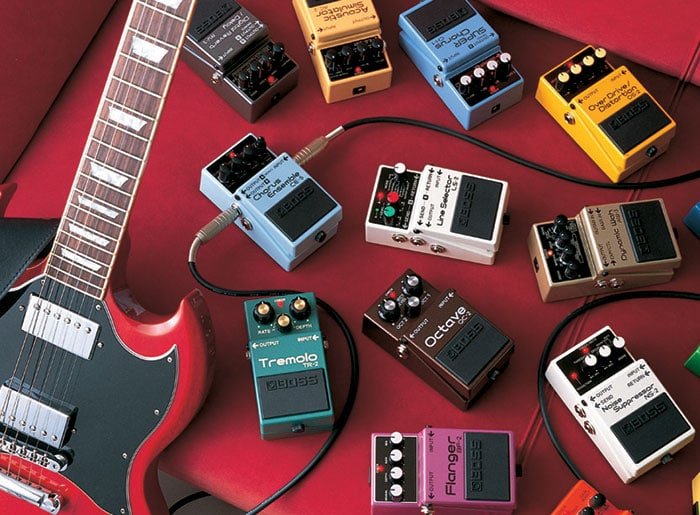
At the time of their release, BOSS Compact Pedals were notable for their bright, colourful exterior. They almost looked like something from outer space!
The choice to use bright colours for BOSS Compact Pedals not only separated them from each other, but gave each one its own individual character and appeal.
The first 3 BOSS Compact Pedals were nicknamed the “Traffic Light” pedals, due to their red, yellow and green colours. While some effects pedals prior to the BOSS Compacts had had paint jobs, this trio looked like a “set” and were easily identifiable on stage.
There have been some consistencies in the colours over the years. For example, BOSS digital delay stompboxes have always been white, phase shifters have always been green, compressors have always been blue, and flangers have always been various shades of purple.
There have also been some colours that seem somewhat random. Distortion stompboxes, for example, have been everything from orange (DS-1, DS-2, and many others) to black (MT-2, HM-2, etc.) to red (XT-2), and several shades in between (although overdrives tend to always be some degree of yellow. Go figure…).
Again, the point is so you can tell which is which in your rig. This is another BOSS first that other stompbox makers have also caught on to, but many others still adhere to the same colour, same look concept.
Next time you get a chance, try out a pedalboard made of stompboxes that all look the same. In the heat of battle in the middle of a gig, on a dark stage with the lights in your face, how easy will it be to tell which is which? Not as easy as a rig full of BOSS stompboxes, to be sure.
4) Silent Switching
Prior to 1977, most effects pedals used a mechanical switch to turn the effect on or off. One issue with this was that it produced a noticeable “click” when the player stepped on it – sometimes distracting from a player’s performance.
Mechanical switching had other problems too. They were susceptible to dirt clogging them and required oiling to make them work smoothly.
BOSS’ new compact pedals were among the first pedals to employ electronic switches, using FET components. This completely eliminated the “clicking” noise produced by conventional mechanical switches, as well as removing the possibility of switches becoming dirty and noisy.
The electronic switch also necessitated the inclusion of a buffer circuit – which ensured that a guitarist’s fundamental tone remained intact down long lengths of cable, even when the effect was disengaged.
5) Keeping The Settings Intact
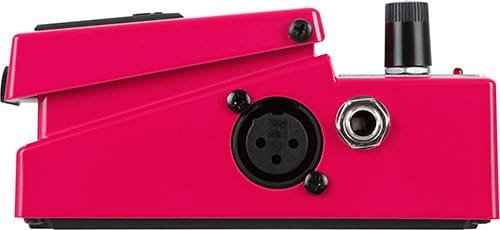
The new designs factored in a careful repositioning of the pedal controls. By placing them a step lower than the switch surface, it helped to prevent setting changes from accidental foot contact when the player turned the effect on or off. This feature had appeared on earlier pedals, such as the Roland Phase II.
6) Is It On? It’s On.
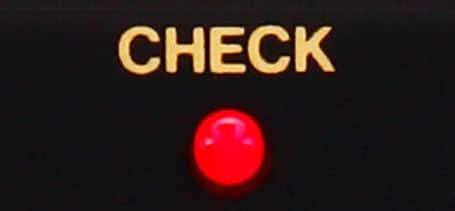
The BOSS Compact Pedal design features a small but clear LED indicator, a feature absent from most effects pedals in 1977. In the very early BOSS pedals, this LED flashed briefly when the player engaged the effect, as a visual reminder to check if the battery had enough power to function.
After a short period of time, BOSS modified the LED behaviour for it to remain illuminated when the effect engaged. It also turned off when the player switched the effect off.
On dark stages and for quickly finding out if the pedal was on, this was a lifesaving function. It consequently became the standard for all FX pedals from then on.
In a “tip of the cap” to the LED’s original design intent as a battery check indicator, the LED on all BOSS Compact Pedals is still labelled simply as “CHECK”.
7) Non-Slip
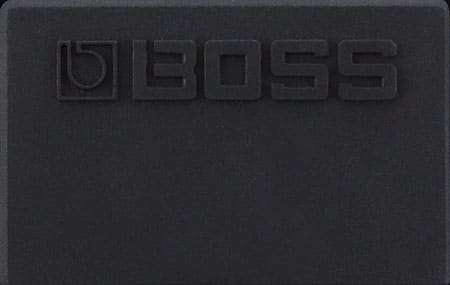
The switch surface on top of the foot pedals had a large, non-slip rubber pad for reliable use. A rubber pad also appeared on the underside of the pedals, ensuring that they didn’t slide all over the stage when kicked on!
As the entire top of the pedal activated the electrical switch underneath when pressed down, the rubber top feature was a brilliant addition to ensure the player got that pedal on!
8) Power To The Pedal
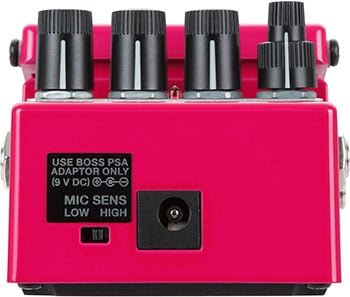
One of the biggest additions was an AC adaptor terminal. BOSS added this to help the user avoid stressing about battery life – something revolutionary in 1977!
Of course, if batteries were still required, simply using the thumbscrew on the pedal to open it gave the player the ability to quickly swap batteries in and out when needed.
The other benefit is that the BOSS Compact Pedal battery compartment is completely sealed off from the components, so if it ever leaks, it won’t contaminate or ruin the electronics.
Prior to this, other pedals required a lot of time and a screwdriver to open them up and replace a battery.
When combined, these design innovations made for an impressive feature set in a compact pedal form. The new BOSS Compact Pedals were genuinely impressive pieces of technical engineering – born from a well thought-out desire to provide a better user experience for the guitar player.
So revolutionary were these design concepts that they truly changed the course of effects pedal design from 1977 on. Just look at nearly any effects pedal today and you’ll almost certainly find at least one feature initially attributable to the BOSS Compact Pedals introduced in 1977.
Related Articles
BOSS CULT CLASSICS
BOSS PEDALS OF THE PROS
TONES IN TIME – 70S ROCK
TONES IN TIME – 60S ROCK
TONES IN TIME – 50S ROCK ‘N ROLL
ECHOES IN TIME: THE HISTORY OF BOSS DELAY PEDALS

